| Menu |
| Homepage |
| NEW & REVISED BOOK! |
| Personal intro |
| Philosophy |
| Intro technics |
| FAQ |
| Exhaust systems |
| Exhaust overview |
| E-type |
| XJ Saloon S1,2,3 |
| XJ40 (AJ6&V12)/X300 |
| XJS |
| XK8/XJ8 |
| TT exhaust explained |
| The Jaguar V12 |
| V12 Performance |
| Stretching the V12 |
| E-type EFI conversion |
| D Jetronic |
| Lucas EFI |
| Vacuum advance |
| Ignition systems |
| V12 throttle linkage |
| Article: V12 Engine |
| V12 Archives |
| The Jaguar AJ6 |
| AJ6 Performance |
| 3.6 Richness |
| AJ6 fault codes |
| AJ6 Archives |
| The Jaguar XK |
| XK Performance |
| Article: XK Engine |
| Article: 4.2 EFI |
| The Jaguar V8 |
| V8 Performance |
| AJ6 Superchargers |
| Superchargers |
| Supercharging article |
| ECU repairs |
| Miscellaneous bits |
| Glossary |
| Prices & ordering |
aj6engineering@ntlworld.com
Updated August 2016
Visitors:
72453541
|
|
From the early 1960s to the present day virtually all serious racing cars have used the classic double wishbone suspension arrangement, or a close variation on the theme. There are many alternatives that have seen widespread use: beam axle, de Dion, swinging arm, trailing arm (even semi-trailing arm), sliding pillar (Morgan, unbelievably in this day and age), McPherson strut (front) and Chapman strut (same thing at rear), but for precise control of wheel movement and low unsprung weight, double wishbones remain the favourite. The beauty of the arrangement is that by careful design of the pivot points and arm lengths the camber of the wheel can be maintained close to the optimum even while the body rolls during cornering. Not only that but the roll centre - a term for the abstract point around which the car rolls when cornering - can be held consistent thereby helping to confer the vehicle with stable handling characteristics. Then there are ways of further refining the handling characteristics by angling the axes of the wishbones in various ways. For instance wheel toe-in and castor angle can be made to vary with body roll to enhance steering feel, or upward suspension deflection can be made to act against the forward weight transfer under braking to oppose front end dip. This is known as anti-dive and a similar arrangement in reverse, known as anti-squat, can be applied at the rear.
Jaguar's legendary Technical Director, William Heynes, knew that independent front suspension was essential for any car that claimed to be advanced and refined, so had adopted double wishbones at the front on the Mk V saloon just after WW2. However the case for independent rear suspension was not so clear cut and even the outstanding D Type had a live axle at the rear, which helps to explain why its greatest successes were nearly always at race tracks with the smoothest surfaces. Obviously this handicap would only become worse so Bob Knight and his team, with one eye on production applications, devised an independent rear suspension for an experimental successor to the D Type known as E2A. Within a year the E Type was launched (1961) with a productionised version of this same independent rear end, incorporating the now familiar rubber mountings as a vibration barrier and trailing arms to provide fore and aft control. It continued with only minor alterations until the last XJ-S left Browns Lane in 1996.
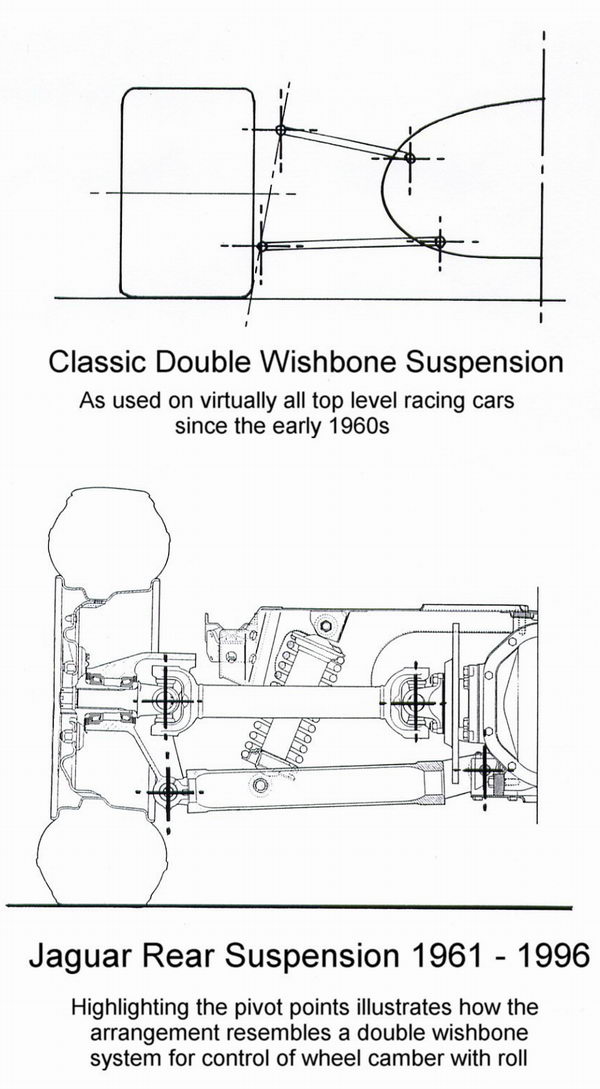
A notable but less well-known member of Bob Knight's team was Derrick White, highly regarded in club racing circles for creating his effective Impala racing car, later moving from Jaguar to be Chief Designer for the Cooper F1 team and then being credited for the Honda/Lola that enabled John Surtees to snatch a lucky win at the 1967 Italian GP. Talent was not a rare commodity at Jaguar in those days.
The point of all this, of course, is to show that Jaguar were near the forefront of vehicle design with suspension systems technically superior to those of most other manufacturers of the time. It may not be obvious but Jaguar's well-known independent rear suspension assembly is geometrically very similar to the double wishbone system preferred by race car designers, in the way wheel camber is controlled. This becomes clearer when the pivot points are highlighted as in the accompanying diagram. Particularly notable is that the driveshaft doubles as the top link so that the under-floor space requirement is kept to the minimum.
In some respects the use of compliant rubber mountings was actually an essential part of the design. For example, for true geometry the forward mounting points of the rear radius arms should be on the same axes as the lower arm inner pivots, but, by being aligned fore and aft, as they are (to be technically correct they should therefore really be called trailing arms), the radius arms generate slight toe-in of the outer wheel under roll which tends to improve stability by opposing oversteer. They are also better able to control torsional loads on the complete axle assembly, even if compliance is necessary for it all to work. Those purists who want to scoff at such compromise should take a look at the rear suspension of the highly regarded Subaru Impreza where rubber mounted trailing arms can be found doing the same thing, 30 or more years after Jaguar first did it.
The arrangement is quite adequate for most people but increased performance from the engine and hard acceleration off-the-line may require some extra means of axle location, easily provided by the HBE anti-tramp kit (photo).
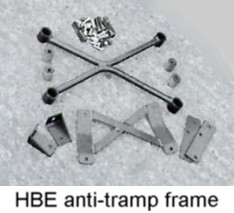
The biggest advances were made with the XJ6, launched in 1968, which for the first time included anti-dive geometry in the front suspension, bringing a subtle benefit in refinement terms by allowing spring rates to be lower because they no longer had to resist dive under braking. Having devised systems that gave good handling Bob Knight took the principle of sub-frames and rubber mountings much further in pursuit of refinement. Let nobody imagine that any old bits of rubber were used - this was scientific. New standards were set for the way in which the occupants were insulated from the road, power-train, and other sources of noise and vibration. A typically clever solution to a very difficult problem was Bob Knight's well known soft gearbox mounting, often derided by those unable to grasp its subtleties, with origins dating back to the original 2.4 saloon of the 1950s.
Bob Knight was well aware of ways in which the rear suspension could be refined further but following his retirement in 1980 it was left to his successor, Jim Randle, to add these and other improvements for XJ40. They included anti-squat/dive geometry and the necessary adjustments to avoid unwanted steer effects plus some very subtle ways of achieving positive location whilst isolating noise and vibration. A more obvious change, one that Bob Knight always wanted to introduce, was to couple the dampers to the bodyshell rather than the suspension structure, as had always been the case at the front of the car, thereby damping the entire system rather than just part of it. Another was to use outboard brakes. Many derided this as a backward step fearful that the increased unsprung weight would adversely affect tyre adhesion, but the advantage is that the wheel bounce frequency is lower and less likely to excite resonances in the body structure. An extra benefit is the removal of the threat of heat to the shaft seals of the differential. The same outboard brakes later appeared for the final few years of the XJ-S. Then in due course the X300 adopted still heavier ventilated outboard rear discs to meet the demands of traction control. Through all these changes nobody seems to have noticed any adhesion deficiency.
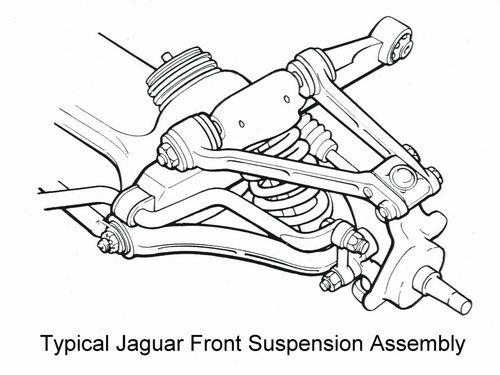
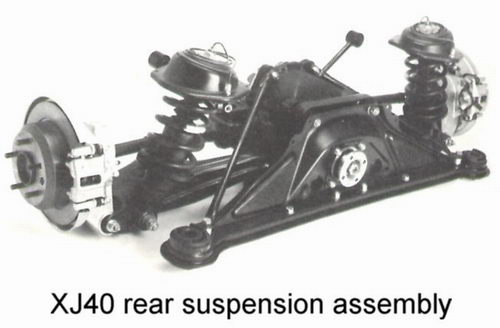
Ultimately, the very compliance that provides the refinement must also detract from the handling qualities as the limit is approached, so the more enthusiastic driver might prefer the car to be slightly firmer. For a road car the trick is to find the right compromise that removes just enough compliance to improve the handling yet does not transmit too much harshness into the bodyshell. Stiffer anti-roll bars are useful but the effect on the balance of the car must always be considered. For instance just increasing the front roll stiffness tends to magnify under-steer (i.e. turn-in will be worse) and vice versa.
Stiffening up the subframe mountings and damper bushes results in a very harsh condition, really only suitable for the track, but changing the steering rack mountings and suspension pivots for polyurethane (Superflex) bushes provides a very acceptable improvement with better durability than the original rubber items, especially when exposed to oil contamination.
When it comes to uprating dampers and springs one has to be mindful of the effort that Jaguar put into this area to obtain the excellent ride qualities that typify their products. It is also worth remembering that the late Colin Chapman, founder of Lotus, who knew a thing or two about suspension and opened the door to modern ground effect in racing, was a long time advocate of soft springs allied to firm damping. Of course, we should not be misled by those dramatic on-car TV camera shots showing how solidly sprung current F1 cars are. Aerodynamic considerations dictate that those cars must have negligible change of attitude and the only way that can be achieved, since the banning of active suspension, is to have minimal suspension movement. For a road car the emphasis should be on improved damping and roll stiffness, but the former cannot be relied upon too much for roll stiffness because of the 'S bend effect' where the car can be caught out holding roll from the first bend as it enters the second.
Any fool can put stiff dampers on a car but, of course, an infinitely stiff damper would just render the suspension totally solid, which would not be desirable even on an F1 car. The XJ-S convertible is a particular example of a car that can be utterly ruined by excessively stiff suspension because of the inherent flexibility of the open top structure. HBE produce a stiffener frame to improve this situation, for those cars built before the factory added something very similar (see photo).
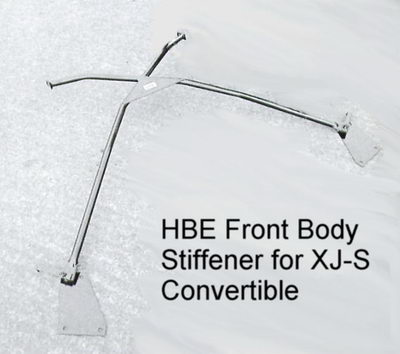
Clearly uprating the suspension requires just as a high a level of expertise as we are able to bring to engine modifications. We therefore offer either HBE's specially valved Bilstein dampers, or for those on a tighter budget the Gaz equivalents, because we know they will genuinely improve the car and not ruin it. The Gaz dampers are also available in adjustable form - the adjustment being applicable simultaneously in both bump and rebound.
So the rule is: use stiffer bushes for the front suspension and steering rack, better damping and stiffer anti-roll bar(s), and you will still have a Jaguar but one with more precise handling. Go beyond that and you will lose too many of the essential qualities that made the car what it is.
Brakes.
Brakes on a Jaguar are one of the better features of the car - although it does not seem to be widely recognised. Far too many people neglect the braking system until one day when slowing hard from high speed the lost efficiency becomes frighteningly obvious. All too often the knee-jerk reaction is to condemn the system and spend loads of money on grooved disks or even larger ones with calipers to suit. For most people it just isn't necessary. The answer is simply to make sure all the braking components are in sound condition and change the fluid at regular intervals as recommended or use a higher specification fluid. Hard though it may be to believe, brake fluid deteriorates by actually absorbing water through the brake hoses so its boiling point gradually falls and the potential for corrosion increases. The accepted life of a standard fluid is 2 years! I wonder how many people reading this can remember when the brake fluid was last changed in their own car?
Even for racing (at club level) the only improvement really necessary would be to use a slightly harder pad material.
Larger front discs and calipers are rarely a good idea on a road car because they do not easily reach operating temperature and are inclined to squeal and be generally unpleasant in daily use.
Email aj6engineering@ntlworld.com, Tel/Fax:- 0044 (0)1625 573556